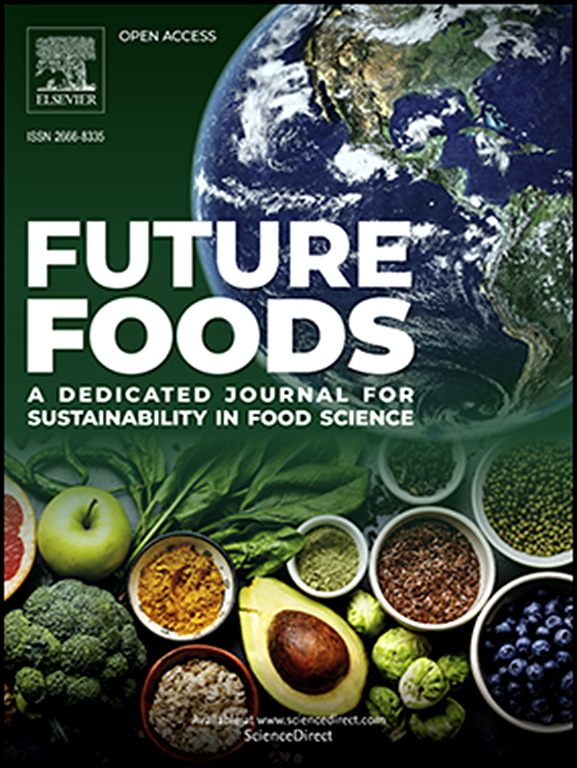使用基于植物的智能包装材料监测食品变质:甲基纤维素/大豆蛋白薄膜,装载甜菜花青素和碳点
IF 7.2
Q1 FOOD SCIENCE & TECHNOLOGY
引用次数: 0
摘要
本研究利用大豆分离蛋白(SPI)和甲基纤维素(MC)制备生物膜,将从紫茉莉花瓣中分离的甜菜青素(mj -b)和碳点(mj - cd)分别装入植物基智能包装材料。以mj - b和mj - cd作为天然显色剂和抗菌剂。扫描电镜分析表明,这些薄膜表面光滑,结构均匀。将MJ-CDs和mjb加入生物膜中,可提高生物膜的抗紫外线性能(从96.8 %提高到99.9%)、润湿性(从49.1°提高到76.3°)和抗拉强度(从29.3 MPa提高到36.3 MPa),并降低其水蒸气渗透率(从2.91降低到2.13 × 10-11 g m/m2)。年代,Pa)。装载MJ-CD/ mjb的生物膜的颜色对pH(2 ~ 12)的变化以及氨蒸汽水平的变化表现出很强的敏感性。通过测定生物膜在25°C条件下对虾的监测和保鲜能力,评估了生物膜的潜在应用价值。在储存过程中,生物膜的颜色从粉红色(新鲜)变为棕黄色(变质),表明它们具有这种功效。这些发现突出了这些新型生物膜在富含蛋白质的新鲜食品质量评估方面的潜力,对食品安全、保质期延长和包装行业的可持续性具有重要意义。本文章由计算机程序翻译,如有差异,请以英文原文为准。

Monitoring food spoilage using smart plant-based packaging materials: Methylcellulose/soy protein films loaded with betacyanin and carbon dots
In this study, novel plant-based smart packaging materials were developed by loading betacyanin (MJ-Bs) and carbon dots (MJ-CDs) isolated from Mirabilis jalapa petals into biofilms fabricated from soy protein isolate (SPI) and methyl cellulose (MC). The MJ-Bs and MJ-CDs were used as natural color indicators and antimicrobials. Based on scanning electron microscopy analysis, these films had smooth surfaces and uniform structures. Incorporating the MJ-CDs and MJBs into the biofilms increased their UV-blocking properties (from 96.8 to 99.9 %), wettability (from 49.1 to 76.3 °), and tensile strength (from 29.3 to 36.3 MPa), and reduced their water vapor permeability (from 2.91 to 2.13 × 10–11 g. m/m2. s. Pa). The color of the MJ-CD/MJB-loaded biofilms exhibited strong sensitivity to changes in pH (2 to 12), as well as to changes in ammonia vapor levels. The potential application of the biofilms was assessed by measuring their ability to monitor and preserve shrimp freshness during storage at 25 °C. The color of the biofilms shifted from pink (fresh) to brownish yellow (spoiled) during storage, indicating their efficacy for this purpose. These findings highlight the potential of these novel biofilms for quality evaluation in protein-rich fresh food products, offering significant implications for food safety, shelf-life extension, and sustainability in the packaging industry.
求助全文
通过发布文献求助,成功后即可免费获取论文全文。
去求助
来源期刊

Future Foods
Agricultural and Biological Sciences-Food Science
CiteScore
8.60
自引率
0.00%
发文量
97
审稿时长
15 weeks
期刊介绍:
Future Foods is a specialized journal that is dedicated to tackling the challenges posed by climate change and the need for sustainability in the realm of food production. The journal recognizes the imperative to transform current food manufacturing and consumption practices to meet the dietary needs of a burgeoning global population while simultaneously curbing environmental degradation.
The mission of Future Foods is to disseminate research that aligns with the goal of fostering the development of innovative technologies and alternative food sources to establish more sustainable food systems. The journal is committed to publishing high-quality, peer-reviewed articles that contribute to the advancement of sustainable food practices.
Abstracting and indexing:
Scopus
Directory of Open Access Journals (DOAJ)
Emerging Sources Citation Index (ESCI)
SCImago Journal Rank (SJR)
SNIP
 求助内容:
求助内容: 应助结果提醒方式:
应助结果提醒方式:


